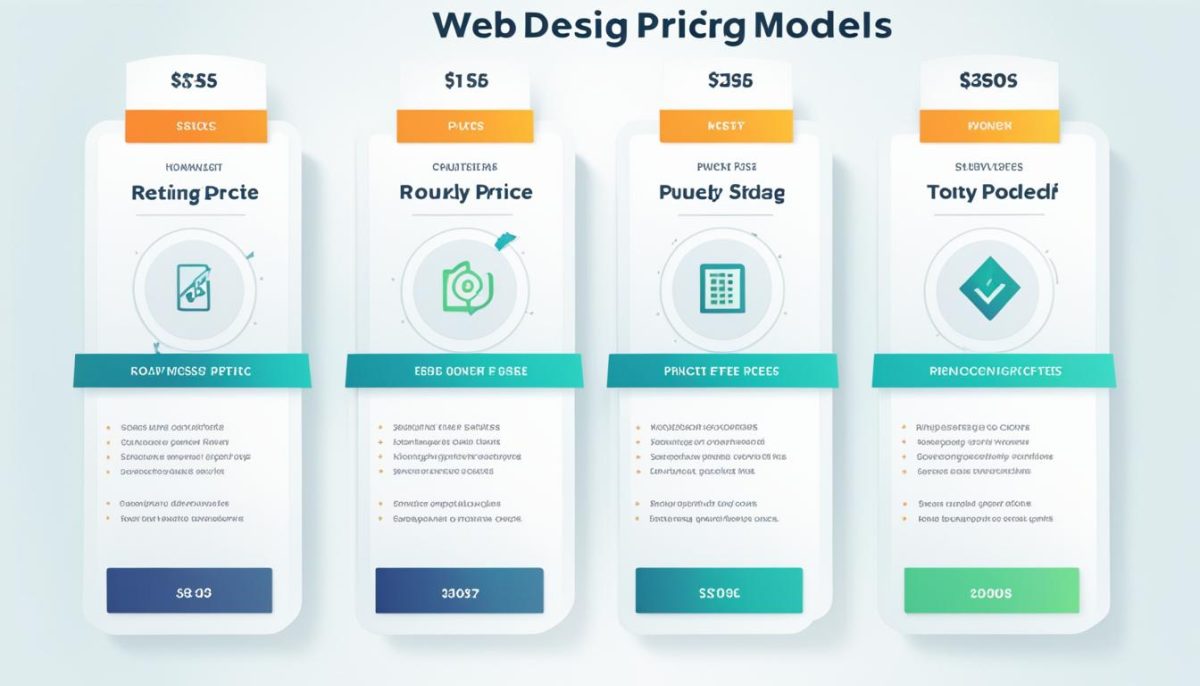When it comes to charging for your web design services, there are several factors that you need to consider. From pricing models to setting competitive rates, it’s essential to find the right balance between being compensated fairly for your skills while keeping your clients satisfied.
In this section, I will provide expert tips and insights on how to charge for web design. Whether you’re just starting your career or looking to refine your pricing strategy, these guidelines will help you navigate the complex world of web design rates.
To begin with, let’s explore the factors that should influence your web design pricing strategy. Understanding these factors will help you determine the most appropriate way to charge for your services and ensure that your rates accurately reflect the value you provide to clients.
Next, we will delve into the different pricing models commonly used in the web design industry. Each pricing model has its advantages and disadvantages, and it’s important to choose the one that aligns best with your business goals and offers the most value to your clients.
After determining the pricing model, we will discuss how to set competitive rates for your web design services. This involves conducting market research, benchmarking against competitors, and positioning yourself based on your expertise and portfolio.
Once you have established your rates, it’s crucial to effectively communicate them to potential clients. Transparent and clear communication, along with justifying your pricing based on the value and benefits you bring, will help establish trust and ensure a smooth negotiation process.
Furthermore, client satisfaction is paramount when it comes to your pricing structure. We will explore how to provide detailed proposals, set clear expectations, and incorporate feedback loops to ensure that both parties are satisfied with the end result.
Lastly, we will discuss the importance of evolving your pricing strategy over time. As the web design industry continues to evolve, it’s essential to regularly evaluate your rates, track profitability, and make adjustments accordingly to stay competitive.
By following these guidelines and considering the various factors involved, you can ensure that you are charging fair and competitive rates for your web design services while maintaining a satisfied clientele.
Factors to Consider When Charging for Web Design
In order to determine the most appropriate way to charge for your web design services, it is crucial to consider several key factors. These factors play a significant role in shaping your pricing strategy and ensuring that you are compensated fairly for your expertise. Let’s explore the factors that should be taken into consideration when charging for web design:
1. Project Complexity
The complexity of a web design project can vary greatly, depending on factors such as the size of the website, the number of pages, the functionality required, and any unique design elements. More complex projects often require a higher level of skill and time commitment, which should be reflected in your pricing.
2. Industry Standards
It’s important to research and understand the industry standards for web design pricing in your area. This will give you an idea of the average rates charged by other professionals in your field and help you position your pricing accordingly.
3. Client Budget
The budget of your client is a critical consideration when determining your pricing strategy. It’s essential to have an open discussion with your client about their budget early on in the process. This will allow you to align your pricing with their financial capabilities and offer appropriate solutions within their means.
4. Your Level of Expertise
Your level of expertise and experience should also be factored into your pricing. If you have years of experience and a strong portfolio, you can justify charging higher rates. On the other hand, if you are just starting out or still building your portfolio, you may need to adjust your pricing accordingly.
“Understanding the factors that influence web design pricing is essential for creating a fair and profitable pricing strategy.”
By carefully considering these factors, you can develop a pricing strategy that reflects the value you bring to each project, while also satisfying your clients’ expectations. Remember that finding the right balance between fair compensation and client satisfaction is key to building successful long-term relationships in the web design industry.
| Factor | Description |
|---|---|
| Project Complexity | The level of complexity and scope of the web design project |
| Industry Standards | The average rates charged by other professionals in the web design industry |
| Client Budget | The financial capabilities of the client |
| Your Level of Expertise | Your years of experience and skill level in web design |
Pricing Models for Web Design
When it comes to pricing your web design services, it’s essential to consider the different pricing models available in the industry. Each model has its own advantages and disadvantages, and understanding them will help you choose the one that aligns best with your business goals and offers the most value to your clients.
1. Hourly Rates:
Charging an hourly rate is a common pricing model for web designers. With this approach, you determine your hourly rate and track the time spent on each project. Hourly rates provide transparency and flexibility, allowing you to charge based on the actual hours worked. However, it’s crucial to carefully estimate project timelines and communicate the potential range of hours required to avoid client concerns about rising costs.
2. Fixed Project Fees:
Another option is to charge a fixed fee for a complete web design project. With this model, you provide a detailed project proposal outlining the scope of work and deliverables, and then set a fixed price for the entire project. Fixed project fees provide clarity for both you and the client and allow you to establish a budget upfront. However, it’s important to accurately assess the scope of work to ensure that the fee adequately compensates you for the time and effort invested.
3. Value-Based Pricing:
Value-based pricing is a model where you set your prices based on the value you deliver to your clients. This approach focuses on the benefits and outcomes your web design services bring to the client’s business, rather than the time and resources invested. By demonstrating the value you can offer, you can justify higher prices and position yourself as a premium service provider. However, value-based pricing requires strong communication skills and the ability to effectively convey the tangible results your clients can expect.
4. Retainer Agreements:
A retainer agreement involves a long-term relationship with your client, where they pay a fixed monthly or annual fee for ongoing web design services. Retainer agreements provide a stable income stream and allow you to develop a deeper understanding of your client’s business. They often include regular website updates, maintenance, and optimization. However, it’s important to clearly define the scope of work and expectations in the retainer agreement to avoid any misunderstandings.
Each of these pricing models has its own merits, and it’s important to consider your business objectives, the specific needs of your clients, and the scope of each project when determining the most suitable model to use. Remember that you can also combine different pricing models for different projects or offer customized pricing solutions based on individual client requirements.

| Pricing Model | Pros | Cons |
|---|---|---|
| Hourly Rates | Transparency, flexibility | Risk of exceeding client budgets |
| Fixed Project Fees | Clarity, predictable budget | Potential under/overestimation of effort |
| Value-Based Pricing | Potential for higher-profit margins, positioning as a premium service | Need for effective communication and value demonstration |
| Retainer Agreements | Stable income, long-term client relationships | Scope creep without clear boundaries |
Setting Competitive Web Design Rates
When it comes to setting rates for web design, it’s important to find a balance that reflects your skills and expertise while remaining competitive in the market. Determining web design fees requires careful consideration of various factors to ensure you are charging what your services are worth.
Market Research and Benchmarking
One of the first steps in setting competitive web design rates is conducting market research. This involves analyzing the prices charged by other web designers in your area and niche. Look for websites and portfolios of professionals with similar experience levels and observe how they price their services.
Setting rates for web design becomes easier when you understand the average pricing in your industry. Benchmarking against competitors helps you position yourself effectively and ensures that you are not charging too much or too little for your services.
Positioning Based on Expertise and Portfolio
Your expertise and the quality of your portfolio play a significant role in determining the value you can offer to clients. If you have specialized skills or extensive experience, you can justify charging higher rates.
Highlighting your unique selling points and showcasing past projects that demonstrate success can help position you as a top web designer in the market. This positions you to command higher rates and attract clients who value quality and expertise.
Negotiations and Pricing Adjustments
As you engage with potential clients, it’s essential to be open to negotiations while maintaining the integrity of your pricing structure. Determining web design fees may involve making adjustments to accommodate client budgets or project requirements.
During negotiations, it’s important to communicate the value and benefits your web design services can bring to the client’s business. By showcasing how your work can enhance their online presence, you can justify the rates you are charging.
Additionally, consider offering different packages or pricing tiers to give clients options that suit their needs and budgets. This flexibility can improve client satisfaction while still ensuring you are compensated fairly for your work.
| Pros | Cons |
|---|---|
| Ability to position yourself as an expert | Potential for pricing yourself out of the market |
| Opportunity to attract clients who value quality over price | May require additional effort in justifying higher rates |
| Possibility of earning higher income per project | Can be more challenging to secure clients initially |
By following these strategies for setting rates for web design, you can position yourself competitively in the market while ensuring your services are appropriately valued. Remember to continuously evaluate and adjust your rates as your skills and experience grow, allowing you to stay profitable and sought-after in the industry.
Communicating Your Pricing to Clients
When it comes to web design, effectively communicating your pricing to clients is a crucial step in building trust and ensuring transparency. By presenting your rates with clarity and justifying them based on the value and benefits your web design services bring to the client’s business, you can increase their understanding and willingness to invest in your expertise.
Transparency is key when discussing web design fees with clients. Clearly outline what your pricing includes and any additional services or options available. Use language that is easy to understand and avoid jargon that might confuse or overwhelm the client.

It’s important to remember that your pricing should reflect the value you provide to the client’s business. Emphasize the positive impact your web design services can have on their online presence, brand image, and customer engagement. Highlight how your expertise and experience will contribute to their success.
As a web designer, my goal is to create a visually appealing and user-friendly website that helps my clients grow their businesses. By investing in high-quality web design, they can attract more customers, establish credibility, and stand out from competitors.
When discussing pricing with clients, be prepared for objections or questions about affordability. Offer options that accommodate different budgets, such as phased payment plans or scaled-down service packages. This flexibility shows that you are willing to work with them to find a solution that meets their needs.
Handling Client Objections and Providing Options
It’s normal for clients to have concerns or reservations about the cost of web design services. Listen attentively to their objections and address them with empathy and professionalism. Explain the value they will gain from investing in your services and how it outweighs the initial cost.
If a client is hesitant due to budget constraints, present them with alternative options that align with their financial capabilities. This could include offering a simplified version of the project, prioritizing key features, or providing a phased approach to the design and development process.
By effectively communicating your pricing to clients and providing options that cater to their needs, you can foster open and productive discussions that lead to mutually beneficial agreements. Remember, transparency, value proposition, and flexibility are key when discussing pricing with clients.
Ensuring Client Satisfaction with Your Pricing Structure
When it comes to web design fees, client satisfaction plays a vital role in building long-lasting relationships and fostering repeat business. To ensure your pricing structure meets the needs and expectations of your clients, there are several strategies you can implement.
Pricing Strategies for Client Satisfaction
1. Provide Detailed Proposals: Crafting detailed proposals that outline the scope of work, project deliverables, and associated costs can significantly enhance client satisfaction. By providing a clear breakdown of the services you will be offering, clients can fully understand the value they will receive from their investment.
Clear and transparent proposals help clients feel confident in their decision to engage your services, as they can assess the direct benefits your web design will bring to their business.
2. Set Clear Expectations: Clearly communicate the project timeline, milestones, and any potential additional costs upfront. By managing expectations from the beginning, you can avoid misunderstandings or disappointments later in the project.
3. Offer Transparent Communication: Maintain open and honest communication with your clients throughout the entire project. Regular progress updates, milestone reviews, and prompt responses to their queries can go a long way in ensuring their satisfaction and building trust.
4. Incorporate Feedback Loops and Revisions: Allow clients the opportunity to provide feedback and make revisions during the design process. This collaborative approach ensures that their vision is met while demonstrating your commitment to delivering a customized solution.
Client participation not only ensures their satisfaction but also allows you to fine-tune the design to match their specific preferences, resulting in a final product that aligns perfectly with their expectations.
Remember, pricing strategies for client satisfaction should be flexible and adaptable to meet the unique needs of different clients and projects. By prioritizing clear communication, transparency, and a collaborative approach, you can ensure that your clients are satisfied not only with the final product but also with the fair and reasonable fees they paid.
Evolving Your Pricing Strategy Over Time
Adapting and evolving your web design pricing strategy is crucial for long-term success in the ever-changing digital landscape. To remain competitive and ensure fair compensation for your services, it is essential to regularly evaluate your rates, track profitability, and adjust as necessary.
Staying proactive and responsive to market trends and client demands is key. As technology evolves, new design trends emerge, and client expectations evolve, it is important to stay ahead of the curve. By keeping a pulse on the industry, you can identify opportunities to provide additional value and differentiate yourself from the competition.
Regularly reviewing your pricing structure allows you to assess whether your rates are still fair, competitive, and sustainable. Analyze your profitability by tracking the time and resources you invest in each project and comparing it to the revenue generated. Adjusting your rates based on this analysis ensures that you are properly compensated for your expertise, while also meeting the ongoing needs of your business.
Remember, it’s not just about adjusting your rates; it’s about continuously improving the overall value you offer. By embracing industry best practices, honing your skills, and expanding your service offerings, you can justify your pricing increases and deliver exceptional results to your clients.




